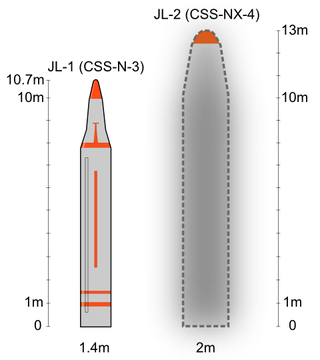Top Qs
Timeline
Chat
Perspective
JL-2
Chinese submarine-launched ballistic missile From Wikipedia, the free encyclopedia
Remove ads
The JL-2 (Chinese: 巨浪-2; pinyin: Jù Làng Èr; lit. 'Giant Wave 2', NATO reporting name CSS-N-14) is a Chinese second-generation intercontinental-range submarine-launched ballistic missile (SLBM) deployed on the People's Liberation Army Navy's (PLAN) Type 094 submarines. It succeeds the JL-1 SLBM deployed on the Type 092 submarine.[7]

The JL-2 provides China with its first viable sea-based nuclear deterrent.[7]
Remove ads
Development
The JL-2 is a naval variant of the land-based DF-31.[8][9] Their common 2-metre diameter solid fuel rocket motor was successfully tested in late 1983,[8] and research and development efforts were reorganized starting in 1985 to produce both missiles.[9]
The first JL-2 at-sea launch occurred in 2001 from a Type 031 submarine.[8][9] The program was delayed after a failed test in 2004.[8] Successful launches occurred in 2005 and 2008. The missile was successfully fired from a Type 094 submarine, the intended operational platform, for the first time in 2009.[8] A series of test launches occurred in 2012.[10]
During the development of the missile, it was reported that China was considering modifying the missile to accommodate an anti-satellite warhead to give it a sea-based anti-satellite capability.[11]
Type 094 deterrence patrols with JL-2 missiles began in December 2015.[1]
As of 2017[update], 48 JL-2 launchers are deployed on submarines.[3]
Remove ads
Description
The JL-2 is a three-stage, solid-fueled missile,[3] with a maximum range of 7,200 km (4,500 mi).[6] Its payload is a single[3] 1 Megaton warhead[5] or 3-8 MIRVs with yields of 20, 90, or 150kt.[2]
References
External links
Wikiwand - on
Seamless Wikipedia browsing. On steroids.
Remove ads

